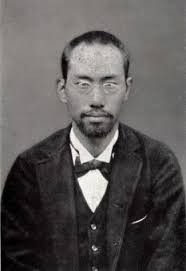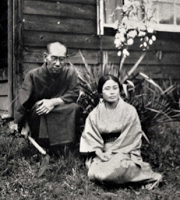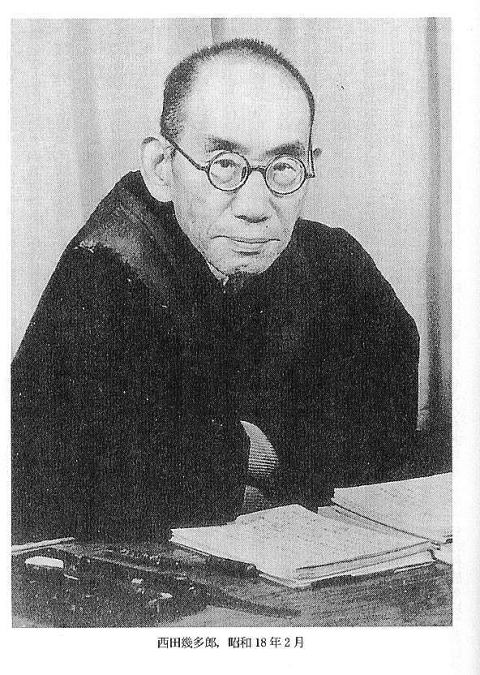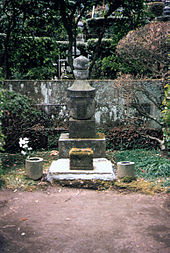People are people
I am I
Unperturbed,
I take the path
I take
(Waka written in 1934, quoted by Michiko Yusa in Zen & Philosophy – An Intellectual Biography of Nishida Kitaro, p 257)
We are very fortunate that, early in his life, as he embarked on his Zen practice, Nishida decided to keep a diary of his thoughts and reactions to the events of his life. The many diaries he left were included in his Collected Works together with much of his correspondence. This material was used by the many scholars who have studied his works, and notably by Michiko Yusa for her book, Zen and Philosophy – An Intellectual Biography of Nishida Kitaro, first published in Japanese, and then translated into English by Yusa herself in 2002. This book is the very best introduction one could dream of, as it weaves Nishida’s life and thinking in a very readable as well as enjoyable biography.
Nishida was born on 19 May 1870, only two years after the Meiji Restoration, in Mori, a small village on the coast of the Sea of Japan, 20 kms away from Kanazawa, capital city of the Ishagawa Prefecture, and he spent most of his first 40 years in Kanazawa.
In the still recent feudal past of the Edo period, daimyo (feudal lords) had been keen to display their power and wealth, and the Maeda family, who founded Kanazawa, had chosen to do so by supporting education and the arts. The town, in fact, was, and still is, known as the “small Kyoto” because of its architecture and its cultural excellence. Nishida enjoyed long walks in its splendid Kenroku-en garden.
Kitaro’s father, Nishida Yasunori, though technically belonging to the class of farmers, held the hereditary function of village mayor, which gave him the right to have a family name and bear arms, both privileges of the samurai. The Nishidas were in fact wealthy landowners with a tradition of reverence for education: Yasunori founded a small private elementary school, where he taught calligraphy, and which Kitaro attended. Yasunori, however, had a penchant for extra-marital affairs, which led to his separation from his wife Tosa, as well as speculation, which led to the loss of his wealth the year Nishida started university in Tokyo. Nishida was very attached to his mother whom he describes as a “woman with an iron will, a devout Pure Land Buddhist, with a heart of gold. She never missed her daily devotion, and out of her boundless compassion she took care of homeless people who came to the village and sought her help” (quoted by Yusa, Zen & Philosophy, 6).
Classical Chinese, Mathematics and Philosophy
Kitaro was the third of five children, with two older sisters, Masa and Nao, a younger sister Sumi and a younger brother Hyojiro. An academically gifted child, Kitaro got private tutorship in Classical Chinese with one of the best teachers of the time, before joining his sister Nao at the Kanazawa Normal School. Fate then struck, and both children caught typhoid. Kitaro survived, but Nao died: this was the first of the many tragedies that marked Nishida’s personal life.
Upon graduating from the Normal School, Nishida returned to private tutorship to study mathematics and English in order to gain admission to Ishikawa Prefecture Senmon Gakko, which he joined in 1886. In Yusa’s words “Senmon Gakko was the preparatory school for Tokyo University. Sons of the former samurai class, for whom learning was an integral part of life, gathered there, making it truly an elite school” (Yusa, 12).
Half-way through his very first year at Senmon Gakko, however, decision was taken by the Japanese Ministry for Education to close the school, and replace it by the Fourth Higher School, with a new administration, which dramatically changed the ethos of the school. All students had to take an exam to re-enter the school. Nishida was successfully re-admitted, but he intensely disliked the new semi-militaristic organisation. In July 1889, Nishida received the report that he had failed his first year of the main division because of his poor attendance and bad classroom conduct, although academically he had done fine.
Nishida decided to drop out of the school and study on his own. But he did so with such enthusiasm that he injured his eyes and was ordered by doctors to stop reading until they heal! He then decided – and that decision turned out to be rather unwise – to take the special entrance examination to the Imperial University in Tokyo.

In September 1891, Nishida was admitted into the Department of Philosophy as a “limited status” (senka) student. “Limited status” students were allowed to borrow books from the university library, but had to sit in a corridor outside the main reading room. It appeared that they were given less attention by the professors, and, at the end of their studies, such students were only awarded a certificate, not a true higher education degree. Ironically, whereas Nishida’s “non-aristocratic” background had not been a problem during his early life, being a senka student undermined his self-confidence, and he made no friends at the Imperial University. He wrote: “In sharp contrast to my higher school days, when I did a lot of things and had many happy memories, I didn’t form a close rapport with professors, nor did I make friends during my university days. Instead of socializing I went to the library every day, read books alone, and thought on my own” (Nishida, quoted by Yusa, 44).
In addition to the philosophy courses taught by Inoue Tetsujiro, and two German teachers – Ludwig Busse and later Raphael von Koeber – Nishida chose to follow the core curriculum required of regular majors. He also took several language courses that were elective, including French and Latin. And he joined the Philosophical Society. Nishida wrote a dissertation on Hume’s Theory of Causation, though this was not required of senka students, and received a certificate when he left the university in 1894.

Nishida got his first teaching appointment the next year. Between 1895 and 1901, he went through a number of positions, often as a teacher of German, the longest being one at the Fourth Higher School, where he taught German and Ethics. By then he had made his first steps as a philosopher, published a number of essays, and began to gain recognition in philosophical circles. In fact, it is while teaching at the Fourth Higher School that he wrote the essays which were published in 1911 under the name of Zen no kenkyu first translated as A Study of Good, and later as An Inquiry into the Good.
Joys, tragedies and Zen practice
By then, having married Kotomi a month after securing his first job, Nishida had also fathered six daughters and two sons, and he had adopted his brother’s daughter, when he died in 1904 while fighting during the Russo-Japanese war. His was a full life indeed, filled with joy as well as pain, as he had to cope with the loss of five of his children …
Most of the scholars who have studied Nishida’s philosophical work have paid little attention to his particularly intense personal life. Yusa’s intellectual biography of Nishida shows that there was a constant interplay between scholarship, life – in the sense of “everyday life” – and Zen practice, and this was the way Nishida had wanted it to be. Having been introduced to Zen Buddhism by his friend D T Suzuki when he was at Tokyo University, he could have followed his friend into a life of contemplation, only trying to blend spirituality with philosophical inquiry. But he felt that life was the raison d’être of scholarship. In his own words, “In the end, scholarship is meaningful only when carried out for the sake of life. Life is of the utmost importance. Scholarship without recourse to life is useless” (Nishida, quoted by Yusa, 68). On the other hand, Yusa notes that it is only after the birth of his first child that Nishida engaged in a serious Zen practice, attending sesshins several times a year, doing zazen morning and evening, and working on koans. Zen practice, however, was also a preparation for philosophical inquiry, as he needed to realise what Buddhism calls “awakening,” and which he came to call the “standpoint of absolute nothingness,” which is also that of the formless self, as it was to be the basis for a different kind of philosophical thinking. “Through his practice of Zen, Nishida was beginning to sense the possibility of carrying out a philosophical inquiry in a wholly different manner, that is, from the vantage point of the “real self” (Yusa, 66).

So, life nourished Zen practice, and Zen practice nourished philosophy, but in the end, though Nishida passed his koan, and his kensho was recognised by his teacher, life was to provide him with a deeper sense of awakening, not through moments of joy, but for the most part through tragedies. Already in 1907, when five year old Yuko succumbed to bronchitis, but especially at the end of the 1910s and in the 1920s, when Nishida faced a series of personal tragedies, namely the loss of his mother, that of his eldest son, the hospitalisation of two of his daughters having caught typhoid, and finally the stroke and long period of paralysis which led to the death of his wife. Yusa writes:
“While Nishida grappled with the pathetic reality of his life, a spiritual transformation was taking place inside him. A break came on February 20, 1923. His diary for that day contains two poems:
“In my heart, is a profound depth that the waves of joys and sorrows do not stir.”
“Devil and Buddha having fought all night long turn out to be but brothers as the new day dawns.”
Nishida realised that there was a “deeper mind” that was beyond the feelings of joys and sorrows, and that embraced those feelings. This was indeed a renewed recognition of the “real self” that Nishida had thought he already knew through his Zen practice. This realisation came over Nishida as a kind of satori, constituting for him an important existential breakthrough … One may even suspect that this experience was at the heart of Nishida’s signature idea of topos (basho; “place” or “field”). The deeper reality of “life” that Nishida had sensed years before through his koan practice was now clearly coming back to him as a renewed, unshakable conviction” (Yusa, 189).
Academic career: an elite school in Tokyo and an innovative university in Kyoto
In 1909, Nishida had finally been able to leave provincial Kanazawa to move to the capital Tokyo, when he obtained a position at Gakushuin. Gakushuin, the Peers School, had been established to educate the children of the Meiji aristocracy, and provided Nishida with opportunities to join the social and intellectual life of the capital city. While teaching there he was approached about a post at Kyoto Imperial University, and in April 1910 he was appointed assistant professor of Ethics at its College of Humanities.
Kyoto Imperial University was a new university and, as Yusa explains, its founders “hoped to distinguish themselves by designing a unique curriculum, and adopting an unconventional method of hiring professors. At Tokyo Imperial University only its own graduates with promising careers in academia were considered for faculty positions; at Kyoto they chose to hire men of talents far beyond the confines of academic walls … a policy of “identifying talents in the wild” (Yusa, 117). It is thanks to this liberal approach that Nishida could be hired, as he had no high school diploma and his “limited status” certificate was not recognised!
Nishida’s first work – Zen no kenkyu – An Inquiry into the Good – published in 1911, sold 750 copies, a healthy number for this type of work. Ten years later, when it was reprinted, it became a best-seller.
In August 1913 Nishida was appointed full professor in Religious Studies, and later that year, he received a doctorate. A year later, at the end of 1914, he was appointed to the first chair in the History of Philosophy.

Many essays now gathered in his Collected Works, but only a few readily available in English
While his first book resonated deeply with his Japanese readers, Nishida insisted that he wanted to be seen as a philosopher in the broad sense of the term, rather than simply a “Zen, or Buddhist,” philosopher. He chose to join a group of Western philosophers who called themselves “empiricists,” and who had begun to rebel against idealism—the assertion that “Being” (reality) is an abstraction based Plato’s “Ideas,” i.e, “words”— thereby calling for a return to “experience.” Nishida read William James’s The Varieties of Religious Experience in 1904, and the works of Henri Bergson soon after. From William James he borrowed the term “pure experience.” In Bergson he found a thinker who had used intuition as the starting point for his philosophical inquiry. Reality as the concrete, lived, and embodied apprehension of the world by the heart-mind was precisely how the East had always understood reality.
Most of Nishida’s works are collections of essays written over a number of years, later gathered into books for the purpose of publication. Nishida saw his work as a whole as the deepening of the initial insight articulated in An Inquiry of the Good as the standpoint of “pure experience.” As he explained in the third Preface of the book, written in 1936: “In Intuition and Reflection in Self-Consciousness, … I developed the standpoint of pure experience into the standpoint of absolute will. Then, in the second half of From the Actor to the Seer, through the mediation of Greek philosophy, I further developed it, this time into the idea of place. In this way I began to lay a logical base for my ideas. I next concretized this idea of place as a dialectical universal and gave that standpoint a direct expression in terms of action-intuition. That which I called in [the Inquiry] the world of direct or pure experience I have now come to think of as the world of historical reality. The world of action-intuition – the world of poiesis – is none other than the world of pure experience” (Nishida, Inquiry, xxxii).
From the Actor to the Seer was published in 1927 just before Nishida’s retirement and represents a significant shift, from his earlier voluntarist stance, modeled after Fichte, to an intuitionist stance, perhaps inspired by his awakening experience of 1923, in any case closer to the approach found in Buddhism and other spiritual quests. It is within this shift to intuitionism that the concept of basho arose where the basho of absolute nothingness was seen as enveloping the basho of relative nothingness – as found in Kant’s idealism (whatever we see in reality is shaped by the structures of our minds) and the “realist” basho of the dichotomy of subject and object in objective consciousness, also found in empiricism.
In the essays written after his retirement, Nishida used “action-intuition” to articulate a dialectic whereby absolute nothingness self-determined itself through the formless self of the individual thus giving form to the world of phenomena. This is what Nishida came to call “self-contradictory identity,” since absolute emptiness (the formless) self-determines into the forms of the phenomena we see – what he later called the historical world – so forms are as it were, “lined” with nothingness, and as such real in their very unreality.

Nishida retired in 1928, but continued to lecture extensively. With the exception of the last years, when the Allied Forces were carrying out bombing raids and food had become scarce, Nishida’s retirement was probably the happiest period of his life. After much hesitation, he had decided to remarry in 1931. He found the perfect companion in Koto, a teacher at one of the new colleges opened for the education of girls, who had a PhD from an American university, and had supported herself with her job for most of her life. The pair divided their time between Kyoto and Kamakura, where the climate was less damp, and Nishida wrote non-stop, producing the bulk of his philosophical output. He published six volumes of Essays on Philosophy. A seventh was published postumously. He penned one of his most important essays just months before his death: “The Logic of the Place of Nothingness and the Religious Worldview” is regarded as the central text around which the Kyoto School of Philosophy developed.
Political life

Japan went through many crises during Nishida’s lifetime but, though he was in contact with a few members of the government, some of them being former students of his, either at the elite school Gakushuin or at Kyoto University, Nishida saw himself primarily as a philosopher involved in an inquiry into the deeper reality of the world. He also saw himself as an educator, and his most vocal warnings against the increasing control imposed by the Japanese government concerned its interference with the running of the university, which started in 1925. Though Nishida shared a sharp criticism of the rise of nationalism in his correspondence, he never saw his life as a politically engaged life, as some of his Marxist colleagues did. As a practitioner of a Western discipline, he was assumed to have Western sympathies, and this attracted suspicion. But, as he was then Japan’s most preeminent philosopher and, during the key period of the 1930’s, already an old man, he was allowed to continue his philosophical inquiry in relative peace. In 1934, he wrote the famous waka “People are people, I am I, Unperturbed, I take the path I take” (quoted by Yusa, 257), now inscribed on a monument near the Philosopher’s Path, where Nishida used to take walks, and which has now become a tourist attraction.
Nishida was in Kamakura, when he died of a renal infection on 7 June, 1945, only two months before the US dropped atomic bombs on Hiroshima and Nagasaki. His lifelong friend D T Suzuki took charge of his funeral service.

